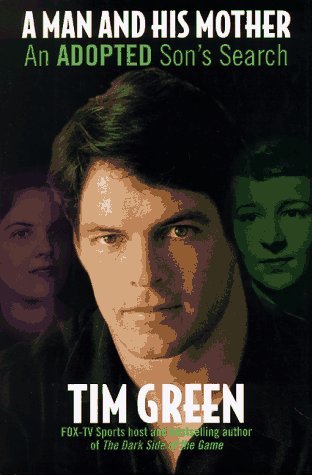
A Man and His Mother:
An Adopted Son’s Search
by Tim Green
Harper Collins, 1997
Reviewed by Barbara Free
In his early life, he refuses to think about the reality of having had any other parents than his adoptive parents. They have a biological daughter and another adopted son. The other son is younger than Tim, and nowhere near as compliant or people-pleasing. Tim knows he doesn’t fit in well with his peers, partly because he is bigger, but also because he does seem to be a compulsive pleaser at home and in school. His primary reason for studying and trying hard in school is also to please his parents. When a friend, also adopted, asks him if he ever thinks about his “other parents,” he becomes angry, leaves, and drops the friendship permanently.
The author sees, in retrospect, that his need to please, his need to have girlfriends, whom he then treats very shabbily, is tied into his relinquishment and adoption. He refers to being “rejected at birth” frequently, based on no information, since he knows nothing about his birth parents nor the circumstances of his birth.
As he succeeds at football and attends Syracuse University on a football scholarship, his drinking and unhealthy relationships both increase, although he does well academically. Just as he graduates, he meets a girl who eventually becomes his wife. He is drafted by the Atlanta Falcons and plays several years, becoming more interested finally in searching for his birth mother.
Because he was born in New York State, the search is not easy, although he has access to private detectives and connections that others might not have, due to his wealth and position. Still, he seems unaware of the existence of support groups or search intermediaries, although he does finally find out about ALMA. During this time, he decides to become a writer, continues to play football, gets married and begins producing babies as fast as possible.
He does not discuss his search with his adoptive parents. At one point, he has to have them sign for him to register with New York State’s passive registry, but his mother is so angry about it that they never discuss it again, not even after he is reunited with his birth mother. He is also busy rescuing the younger brother during this time, whom the parents have apparently totally disowned. This young man seems to take no responsibility for his behavior, other than to cry and manipulate his wife and others through self-pity. Admittedly, this reviewer is a therapist and notices these characteristics more than other readers might.
The book is pretty well written, and would be a good one for adoptees in search to read, particularly adult male adoptees. The reader may not want to follow in this young man’s footsteps in the method of searching, or in the avoidance of dealing with the issues with his adoptive parents. Oddly enough, although he repeatedly rescues the brother financially and even physically, he does not encourage or help him when he wants to search for his own birth parents, deciding “it might not he a good idea in his case.” As previously stated, this seems rather grandiose on his part to decide that he should have the right to search but someone else shouldn’t. He states, more than once, that adoptees rarely find their birth parents, and that it is even more rare that the story has a happy ending. We do not know what research these statements are based upon; we have never heard this in adoption support circles. This seems to be more evidence of the author’s wish to be unique, one of the few who succeeded.
This book reads fairly fast, and is a good exploration of the thoughts, feelings, and behaviors of one adult male adoptee.
Excerpted from the July 2000 edition of the Operation Identity Newsletter
© 2000 Operation Identity